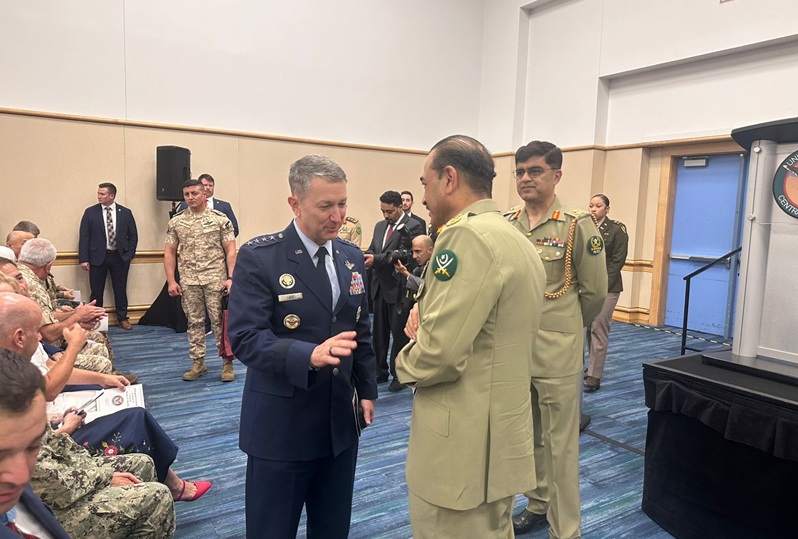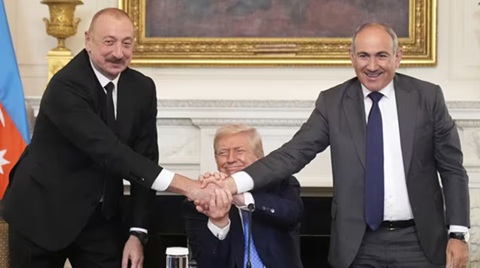To analyze the regional situation and connect the events involving Pakistan’s Chief of Army Staff (COAS) Field Marshal Syed Asim Munir’s White House visit in June 2025, the C5+1 nations’ army chiefs meeting at GHQ Rawalpindi, the Armenia-Azerbaijan peace agreement, and Munir’s subsequent U.S. visit in August 2025, we need to consider the geopolitical, military, and diplomatic implications.
These events reflect Pakistan’s growing strategic relevance, U.S. foreign policy priorities, and shifting regional dynamics in South Asia, Central Asia, and the Caucasus.
1. Asim Munir’s White House Visit (June 2025)
Field Marshal Asim Munir’s meeting with U.S. President Donald Trump at the White House on June 18, 2025, was a significant diplomatic event, marking the first time in decades that a Pakistani military leader met a U.S. president without civilian leadership present. The closed-door meeting focused on regional security, counterterrorism, Pakistan-India tensions, and the Iran-Israel conflict. Key points include:
Context and Symbolism: The White House setting, rather than the Pentagon, signaled U.S. recognition of Pakistan’s military as a central power in its foreign policy, reflecting pragmatic engagement with Pakistan’s institutional realities. Trump praised Munir for his role in de-escalating India-Pakistan tensions. Munir’s reported suggestion that Trump be nominated for a Nobel Peace Prize for averting escalation underscores Pakistan’s diplomatic alignment with U.S. interests.
Discussion Points: The agenda included counterterrorism cooperation (e.g., Pakistan’s capture of Mohammad Sharifullah, a planner of the 2021 Kabul airport bombing), Pakistan’s stance on the Iran-Israel war, and potential trade deals, including access to Pakistan’s oil reserves. Trump’s imposition of a 19% tariff on Pakistani goods (down from 29%) suggests economic negotiations were also in play.
Regional Implications: The visit highlighted Pakistan’s role as a regional stabilizer, particularly in managing tensions with India and navigating ties with Iran and China. Munir’s balanced stance—supporting Iran but endorsing U.S.-led de-escalation—reflects Pakistan’s delicate diplomatic tightrope. The absence of civilian leaders underscored the military’s dominance in Pakistan’s foreign policy, a point of contention domestically but a pragmatic choice for U.S. engagement.
2. C5+1 Nations’ Army Chiefs Meeting at GHQ Rawalpindi
The C5+1 framework includes the five Central Asian states (Kazakhstan, Uzbekistan, Turkmenistan, Kyrgyzstan, Tajikistan) plus the United States. A meeting of their army chiefs at Pakistan’s General Headquarters (GHQ) in Rawalpindi, indicates Pakistan’s growing engagement with Central Asia and the U.S. in a military context. This event occurred in the context of broader regional security discussions, around the same period as General Michael Kurilla’s visit to Pakistan, where he received the Nishan-e-Imtiaz.
Strategic Significance: The C5+1 meeting at GHQ reflects Pakistan’s strategic positioning as a bridge between South Asia, Central Asia, and the U.S. Central Asia is critical for energy resources, trade routes (e.g., China-Pakistan Economic Corridor), and counterterrorism efforts, particularly against groups like Daesh-Khorasan. Pakistan’s hosting of such a meeting underscores its military’s role in regional security coordination, leveraging its geographic proximity and historical ties with Central Asian states.
U.S.-Pakistan Military Ties: General Kurilla’s description of Pakistan as a “phenomenal partner” in counterterrorism during a U.S. Congress hearing in June 2025 highlights the deepening U.S.-Pakistan military collaboration. The C5+1 meeting likely focused on shared security challenges, such as terrorism and regional stability, aligning with U.S. Central Command’s (CENTCOM) priorities in the region.
Regional Implications: The meeting signals Pakistan’s ambition to expand its influence in Central Asia, potentially as a counterbalance to India’s growing ties with the region (e.g., through the Shanghai Cooperation Organisation). It also reflects U.S. efforts to counter Chinese and Russian influence in Central Asia by engaging Pakistan as a regional partner.
3. Armenia-Azerbaijan Peace Agreement (August 2025)
On August 8, 2025, U.S. President Trump hosted a trilateral summit with Azerbaijan’s President Ilham Aliyev and Armenia’s Prime Minister Nikol Pashinyan, resulting in a historic peace agreement to resolve their 35-year conflict. The accord, described as a U.S.-brokered deal, aimed to end hostilities and foster regional stability in the Caucasus.
U.S. Role: The agreement reflects Trump’s emphasis on positioning himself as a “President of peace,” as stated by Secretary of State Rubio. The U.S. leveraged its diplomatic influence to mediate, potentially to counter Russian and Turkish dominance in the Caucasus and secure a geopolitical win.
Regional Implications: The peace deal stabilizes the South Caucasus, a critical region for energy pipelines (e.g., Baku-Tbilisi-Ceyhan) and trade routes connecting Europe and Asia. It reduces the risk of conflict spillovers affecting neighboring regions, including Central Asia and South Asia, where Pakistan has interests.
4. Asim Munir’s Second U.S. Visit (August 2025)
Munir’s second visit to the U.S. in less than two months, reported on August 7–10, 2025, involved attending the CENTCOM change-of-command ceremony in Tampa, where General Michael Kurilla retired and Admiral Brad Cooper assumed command. Munir also met General Dan Caine, Chairman of the Joint Chiefs of Staff, and engaged with the Pakistani diaspora.
Purpose and Activities: Munir praised Kurilla’s contributions to U.S.-Pakistan military ties and expressed confidence in continued collaboration with Cooper. Discussions with Caine focused on mutual professional interests and regional security, with Munir inviting Caine to Pakistan. His diaspora engagement emphasized Pakistan’s economic potential and encouraged investment.
Geopolitical Context: The visit followed heightened India-U.S. tensions over trade tariffs and India’s rejection of foreign influence in its Pakistan ceasefire. Munir’s frequent U.S. engagements suggest Pakistan is capitalizing on these tensions to strengthen its strategic partnership with Washington, positioning itself as a reliable ally in a volatile region.
Regional Implications: The visit reinforces Pakistan’s role in U.S. strategic calculations, particularly in counterterrorism and regional stability. Munir’s meetings with defense chiefs from friendly nations indicate broader coalition-building efforts.
Connecting the Dots: Regional Situation Analysis
These events collectively highlight Pakistan’s pivotal role in a complex geopolitical landscape, with implications for South Asia, Central Asia, and the broader U.S. foreign policy framework:
1. Pakistan’s Strategic Positioning:
– Munir’s White House visit and subsequent U.S. trip underscore Pakistan’s military as a primary interlocutor in U.S.-Pakistan relations, reflecting Washington’s pragmatic engagement with Rawalpindi over Islamabad. This dynamic strengthens Pakistan’s leverage in regional security but raises concerns about civil-military imbalances domestically.
– The C5+1 meeting at GHQ positions Pakistan as a key player in Central Asian security, aligning with U.S. efforts to counter China and Russia. Pakistan’s military diplomacy complements its economic ambitions, such as the China-Pakistan Economic Corridor (CPEC), while expanding its regional influence.
– Munir’s balanced stance on Iran and India reflects Pakistan’s attempt to navigate competing alliances, maintaining ties with the U.S., China, and Iran while managing tensions with India.
2. U.S. Foreign Policy Priorities:
– The U.S. is leveraging Pakistan’s military to address regional challenges, including counterterrorism, India-Pakistan tensions, and the Iran-Israel conflict. Munir’s capture of Sharifullah and cooperation with CENTCOM strengthens Pakistan’s case for renewed U.S. military aid.
– The Armenia-Azerbaijan peace deal demonstrates Trump’s focus on high-profile diplomatic wins, potentially to offset tensions with allies like India over trade policies. Pakistan’s alignment with U.S. mediation efforts (e.g., on Iran) aligns with this broader strategy.
The C5+1 engagement reflects U.S. efforts to secure influence in Central Asia, using Pakistan as a partner to counterbalance China’s Belt and Road Initiative and Russia’s regional dominance.
3. South Asia and India-Pakistan Dynamics:
– India’s Operation Sindoor and the subsequent ceasefire, attributed by Trump to Munir’s restraint, highlight Pakistan’s role in preventing escalation. However, India’s insistence on bilateral resolution and rejection of foreign mediation (e.g., by Trump) underscores ongoing tensions.
– The U.S.’s engagement with Munir, especially amid strained India-U.S. relations over trade tariffs, suggests Washington is hedging its bets by strengthening ties with Pakistan to balance India’s regional influence.
– Pakistan’s military diplomacy, including the C5+1 meeting, may also aim to counter India’s growing ties with Central Asian states, positioning Pakistan as a regional security hub.
4. Central Asia and Caucasus Linkages:
– The Armenia-Azerbaijan peace deal stabilizes a region critical for energy and trade routes, indirectly benefiting Pakistan’s ambitions to connect South and Central Asia via CPEC.
– The C5+1 meeting at GHQ aligns with U.S. and Pakistani interests in securing Central Asia against terrorism and geopolitical competition, reinforcing Pakistan’s role as a connector between regions.
5. Counterterrorism and Regional Stability:
– Pakistan’s cooperation with the U.S. on counterterrorism, exemplified by the Sharifullah capture, strengthens its strategic partnership with Washington. This aligns with the C5+1 framework’s focus on regional security, particularly against groups like Daesh-Khorasan.
– Munir’s diaspora engagement emphasizes economic stability, which is critical for Pakistan to sustain its military and diplomatic initiatives amid domestic challenges.
Critical Perspective
While the U.S. engagement with Munir reflects strategic pragmatism, it risks reinforcing Pakistan’s military dominance over civilian governance, potentially undermining democratic institutions. The narrative of Trump brokering an India-Pakistan ceasefire is contested by India, which insists on bilateral resolution, suggesting U.S. claims may be exaggerated for diplomatic leverage.
The Armenia-Azerbaijan deal, while a U.S. success, may face implementation challenges given historical animosities and external influences (e.g., Russia, Turkey).
Pakistan’s growing role in Central Asia via C5+1 is promising but constrained by its domestic instability and economic challenges, which could limit its regional ambitions.
Conclusion
The interconnected events—Munir’s White House visit, the C5+1 meeting, the Armenia-Azerbaijan peace agreement, and Munir’s second U.S. visit—illustrate Pakistan’s rising strategic importance in a volatile region.
The U.S. is leveraging Pakistan’s military to address counterterrorism, regional stability, and geopolitical competition, while Pakistan is positioning itself as a bridge between South Asia, Central Asia, and global powers.
However, tensions with India, domestic civil-military dynamics, and the complexities of Central Asian and Caucasian geopolitics pose challenges. These developments reflect a broader U.S. strategy to secure influence in critical regions, with Pakistan as a key, albeit complex, partner.
Discover more from Defence Talks | Defense News Hub, Military Updates, Security Insights
Subscribe to get the latest posts sent to your email.





